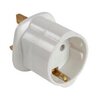Seems most folk these days are swimming around in a sea of cheap imported mains powered /plugable chinese electricals, often found plugged into rows of 4 way extensions
Should not electrical items that you plug in - conform to certain BS/EU standards, and be tested as such. What is the UK standard that such 'disposable tech' should be tested and certified to.
CE marking is one such, but now we are out the EU, what replaces it.
I have one or two cheap chinese electrical items that came direct from China myself - with the CE stamp on, but how do you know the CE marking is genuine.
I am soon to learn PAT testing, to test tenants personal electrical items, and am wondering if you are to be able to inform the tenant that the item does/does not conform to required standards.
I have bought some 'hot plug indicators' for any extension leads I find (I already check for diasy chaining and coiled extension leads), and wouldn't expect items such as these to not be to standard, but again should you be checking for CE marking or the like.
Should not electrical items that you plug in - conform to certain BS/EU standards, and be tested as such. What is the UK standard that such 'disposable tech' should be tested and certified to.
CE marking is one such, but now we are out the EU, what replaces it.
I have one or two cheap chinese electrical items that came direct from China myself - with the CE stamp on, but how do you know the CE marking is genuine.
I am soon to learn PAT testing, to test tenants personal electrical items, and am wondering if you are to be able to inform the tenant that the item does/does not conform to required standards.
I have bought some 'hot plug indicators' for any extension leads I find (I already check for diasy chaining and coiled extension leads), and wouldn't expect items such as these to not be to standard, but again should you be checking for CE marking or the like.






